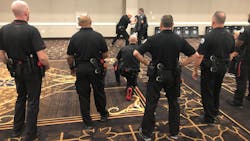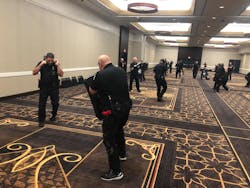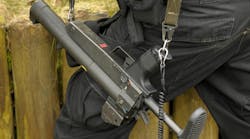In the wake of high-profile officer-involved incidents over the past couple of years, calls for police reform have grown louder and there has been a push for new policies and de-escalation tactics. Proponents of less-lethal techniques have stressed the equal importance of properly training law enforcement officers how to swiftly end confrontations and avoid the missteps that could land officers and their agencies in the national spotlight.
Armament Systems and Procedures, Inc. (ASP), which was the first in the market to produce expandable batons in the 1970s and has since added handcuffs and flashlights to its line of products, has offered training free-of-charge for close to 40 years. OFFICER Magazine spoke with Daryell Harmon, Vice President of Sales for ASP, and ASP trainers Eric Snyder and James Schramm, about the company’s program, current trends in less-lethal training and why officers must be trained in less-lethal techniques throughout their careers.The evolution of training
ASP launched its training program in 1987 with courses dedicated to expandable batons. “We had done some instructor-type programs before then, but that was really, to me, the real birth of the actual program with trainers,” says Harmon, who oversees the company’s training division. “We take law enforcement officers who go through our instructor-level courses, taught by ASP trainers, and if they stand out and are willing to put in the time, then we nominate them to come to trainer conferences.”
ASP conducts training in 107 countries. Each year, the company holds 65 to 70 instructor certification classes. While the program began with batons, the company added training for handcuffs in the early 2000s and in 2015 it introduced flashlights into the program. ASP’s Integrated Training (Tactical Baton, Restraint and Performance Flashlight) program teaches techniques for all three tools.
“Our philosophy is, we create top-tier products, and we consider it an obligation to educate officers on how to properly utilize those products,” says Harmon. “Under very stressful situations, they need to be able to replicate what we’re teaching them in the class, and it’s got to be able to work not only in the classroom, but in the streets.”
The company keeps its protocols consistent so that a class taught in the United States will be exactly the same as one taught in France or Spain. “Though the course contents have evolved along with the equipment over the years, the fundamentals have stayed consistent since the program was first developed by our founder, Dr. Kevin Parsons.’ ”
Eric Snyder is an officer in Ames, Iowa, and has been in law enforcement for 16 years. “I started straight out of college and quickly learned that law enforcement training doesn’t really give you enough tools to do the job really well; it gives you really the basic knowledge, the basic minimum things that you need,” he says. “So, I started seeking out training on my own and just found that I liked to do it and I like to teach it. I went down that path in my agency and also started teaching outside my agency. I have a passion for mostly non-firearms self-defense.”
He began teaching civilians and then trained officers within his own department, and looked for certification programs to be able to teach different weapon systems and different types of self-defense systems. He first took part in the ASP training program about 10 years ago. “I was really impressed with the program and the instructors. They just seemed to be really dialed in instructors. It was just a good initial impression.” He went again recently and found the program had been updated and a lot of advancements had been made. “They are on the cutting edge of the training world instead of just swinging a baton, which is what most people think that it is. There’s a lot more to it in the way that they integrate their training.” He was invited to take part in the ASP Trainer Certification in Las Vegas this past fall. “That experience was very eye-opening as to what the company does and why they have such a strong training program.”
Integrated training
James Schramm, a retired NYPD officer, started his career in 1991 and in December 2000 was transferred to the Tactical Training Unit, which is responsible for less-lethal training for In-service officers and officers assigned to plain clothes units. “I definitely saw an evolution in the training from old-school martial arts to a more practical approach. Trainers were usually more concerned about showing their skills off than actually teaching useful techniques,” he says. “The training has to not only work in the training room, but it has to translate to the street, with the added stress of the unknown.”
He says most agencies at that time taught techniques that weren’t applicable to the officer on the street. “Techniques like weapon disarming, pressure point control, escorts with the baton; these techniques work when your partner is motionless and compliant but not on a combative individual on the street. A good defensive tactics program needs to be effective for the majority of your officers no matter their size, skill or prior training.”
Schramm stresses that simplicity is the key. “Most officers only get one to two training days a year of defensive tactics. Officers should be training all the time with the concepts and principles they learn, and the tools that they carry. I’m not saying full days of training every week, but definitely add a few minutes every day that you train at the gym or even at home.”Having a program that includes a variety of tools and techniques is an important part of less-lethal training, he adds. “We use an integrated approach to training. We cover empty hand techniques, restraint concepts, baton strikes and defensive illumination. All drills at the end of training incorporate all tools and concepts, just like the realities of the street.”
Harmon says that when ASP first introduced flashlights into the training program, even trainers who had been with the company for more than a decade said, “What are you going to do? It’s easy, On/Off. There it is. There’s your flashlight program.” But he says that it was more involved than he even thought it would be and took about three years to develop the program. “They are tools in how we utilize the light as a distraction technique and we distract, disorient, disable the bad guy.”
Snyder says that the addition of flashlights into the program is extremely helpful when it comes to expanding an officer’s skillset. “There’s not a lot of law enforcement flashlight training that doesn’t include a firearm. This is the first one that I’ve seen that includes how to use a flashlight in a patrol setting in a realistic way that works with what you’re going to do when you’re writing a ticket and when you happen to be in a physical confrontation.”
Harmon says that the training program doesn’t use handcuffs to do takedowns or other techniques, but they are used to do one thing: restrain the suspect. “But being able to transition from an actual person attacking you—for you to be able to gain space, for you to utilize strikes and then be able to rapidly stow that baton and deploy your handcuffs—how they actually interact with each other, that took a lot of time in finding the right way to do it.”
The program was designed so that the techniques are simple to learn and easy to understand and remember. “Finding what order things go in and finding out how we can make that safe for an officer. That’s been a big deal. That’s probably what took us the longest time and we had to continue to test it and refine it and then battle test it in the streets to make sure it was correct.”
The extendable baton should be seen as both a tool and a weapon, according to Harmon. “I can use it as more than a striking tool to defend somebody. I can break a window on a car and rescue a kid in the middle of a hot day. Someone who is passed out and the car is on fire, I can break a window or pry a door and I can get them out. It fills in gaps not just as an officer defense tool, but as a public safety tool.”
Budgeting for training
One of the first things agencies are often forced to cut is training budgets. “Every chief will say, ‘I don’t want my guys fighting because it looks bad.’ Tell me one fight that looks good?,” says Harmon. “A fight by its very nature is violent. Why would you cut training and say, ‘I’m going to not do this because I don’t want guys to fight, because now that they have training, they might fight.’ Well yes, they might fight, but they might learn how to end a fight quicker. They might learn how to speak to somebody and end the fight. Just deploying the baton might end it.”
While Snyder says there is a lot of training available on the market that focuses on buzzwords and hot topics, less-lethal training often gets overlooked. “I think that this type of training bridges a gap that most officers need on the street and could potentially reduce negative outcomes if law enforcement was able to focus more on these things. Unfortunately, that’s not happening around the country as often as it should.”
He added that cost has been a challenge when it comes to less-lethal training for law enforcement. “There’s been a lot of training that I’ve either had to pay out of my pocket if I really wanted to go or I just couldn’t go to because the cost was too high. This was an easy one. In fact, I wasn’t scheduled to go to the training that got me invited to the Vegas training. Because it was free, my supervisors said, ‘We have enough people working, lets send all of our instructors to this class.’ It opens up that ability, as long as staffing works in an agency, they can send as many people as they want to get high quality training and bring it back.”COVID’s effect on training
In March of 2020, ASP suspended its training program until the fall due to the COVID-19 pandemic. New protocols were established to help prevent the potential spread of the virus. “As things have progressed it’s almost back to what we had (before the pandemic),” says Harmon. “You look at the local governments and whatever the local rules are there is what we adhere to when it comes to what the rules are as far as COVID goes.”
Snyder says that the pandemic forced everyone to take a look at what was important and what wasn’t. “We either weren’t allowed to or had very limited access to in-person training. You really had to decide is it valuable or not. But then, there just wasn’t a lot of training available for a while. In the aftermath of all of that, officers and agencies are hungry for training.”
Now that training programs are back in full swing, Schramm says that an emphasis has to be put on less-lethal training for officers so that they are ready for the streets. “I believe that officers are the ultimate professional athlete and just like professional athletes, they need to be training year-round. The difference is our decisions could be life or death. We have to become a master of the basics.”
Learn more about ASP training at asp-usa.com/pages/training-programs






